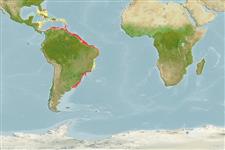>
Eupercaria/misc (Various families in series Eupercaria) >
Sciaenidae (Drums or croakers)
Etymology: Micropogonias: Greek, mikros = small + greek, pogon = beard (Ref. 45335).
Issue
The species Micropogonias opercularis (Quoy & Gaimard, 1825) is considered as valid in Eschmeyer (CofF ver. Jul. 2010: Ref. 84883) according to López et al. (2002: Ref. 80900).
Environment: milieu / climate zone / depth range / distribution range
Ecología
marino; salobre demersal; oceanodromo (Ref. 51243); rango de profundidad ? - 60 m (Ref. 9626), usually 20 - 40 m (Ref. 9626). Subtropical; 27°N - 36°S, 84°W - 34°W (Ref. 54591)
Western to Southwest Atlantic: Greater Antilles and from Costa Rica to Argentina (Ref. 9626). Also reported in Nicaragua (Ref. 13613). Also reported in Brazil (Ref. 118626).
Length at first maturity / Tamaño / Peso / Age
Maturity: Lm 30.6 range ? - ? cm
Max length : 60.0 cm SL macho / no sexado; (Ref. 27363); common length : 45.0 cm SL macho / no sexado; (Ref. 27363); peso máximo publicado: 55.30 g (Ref. 118626); edad máxima reportada: 7 años (Ref. 27)
Espinas dorsales (total): 11; Radios blandos dorsales (total): 26-30; Espinas anales 2; Radios blandos anales: 7 - 9. Body silvery with a golden cast, back greyish, with distinct oblique dark streaks along scale rows extending to much below lateral line; spinous dorsal without small dark dots (Ref. 27363).
Found over muddy and sandy bottoms in coastal waters and in estuaries where the nursery and feeding grounds are located. Adults form schools. Feeding habits vary with ontogenic development and season; juveniles feed on benthic migratory crustaceans and sessile boring mollusks while adults are benthos-feeders and occasionally capture fish (Ref. 27). Undergoes seasonal migration. An important food fish which is usually marketed fresh and salted.
Isaac, V.J., 1988. Synopsis of biological data on the whitemouth croaker, Micropogonias furnieri (Desmarest, 1823). FAO Fish. Synop. (150). (Ref. 27)
IUCN Red List Status (Ref. 130435)
Threat to humans
Harmless
Human uses
Pesquerías: muy comercial
Más información
ColaboradoresImágenesStamps, Coins Misc.SonidosCiguateraVelocidadTipo de nataciónSuperficie branquialOtolitosCerebrosVisión
Herramientas
Special reports
Download XML
Fuentes de Internet
Estimates based on models
Preferred temperature (Ref.
123201): 16.5 - 28, mean 26.6 °C (based on 196 cells).
Phylogenetic diversity index (Ref.
82804): PD
50 = 0.5156 [Uniqueness, from 0.5 = low to 2.0 = high].
Bayesian length-weight: a=0.00933 (0.00774 - 0.01126), b=3.02 (2.96 - 3.08), in cm total length, based on LWR estimates for this species (Ref.
93245).
Nivel trófico (Ref.
69278): 3.1 ±0.1 se; based on diet studies.
Generation time: 6.1 (4.3 - 8.5) years. Estimated as median ln(3)/K based on 13
growth studies.
Resiliencia (Ref.
120179): Medio, población duplicada en un tiempo mínimo de 1.4-4.4 años (K=0.12-0.18; tmax=7).
Prior r = 0.71, 95% CL = 0.47 - 1.06, Based on 4 stock assessments.
Fishing Vulnerability (Ref.
59153): Moderate vulnerability (44 of 100).
Climate Vulnerability (Ref.
125649): Moderate vulnerability (43 of 100).
Nutrients (Ref.
124155): Calcium = 82.4 [47.1, 158.8] mg/100g; Iron = 1.07 [0.58, 1.86] mg/100g; Protein = 20 [18, 22] %; Omega3 = 0.265 [0.134, 0.513] g/100g; Selenium = 28.3 [15.5, 53.0] μg/100g; VitaminA = 7.34 [2.76, 23.48] μg/100g; Zinc = 0.86 [0.63, 1.26] mg/100g (wet weight); based on
nutrient studies.
